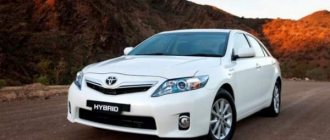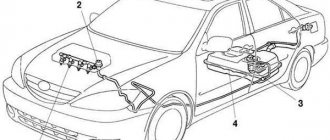Camry 2.5 2015. Test drive results
The exterior of the 2015 model has not undergone significant changes when compared to the previous version. The designers did their job with care to retain the core audience. The Camry gets a new front bumper with fog lights, updated headlights with LEDs and a redesigned grille. The “face” of the car has now become more expressive.
the most attention during test drives of the 2015 Camry 2.5 is its interior. It has been completely rethought. The dashboard was replaced in the cabin. Now it looks more elegant and has a blue backlight. The passenger row, designed with an emphasis on comfort, is very comfortable for people of any height. The presence of wireless charging for gadgets has become a bonus for all customers. The main changes affected the steering wheel. It has a thicker rim, making it more pleasant for the driver to drive the car.
The updated engine is the main reason why I took the 2015 Camry for a test drive. The 2.5 liter volume, combined with an improved gearbox, makes its presence felt. The car accelerates to 100 km/h in 9 seconds with 181 hp. s., and the speed is limited to 210 km/h. The Camry starts instantly and shifts gears without any delays. The engine is very responsive and has enough power to handle any terrain. Fuel consumption – 13.5 liters per 100 km.
It is especially important that the sound of the engine running in the cabin is practically inaudible.
The test drive video will help you understand the features of the 2015 version.
Toyota Camry III generation XV10
Some despise her and hate her fiercely, hurling derogatory epithets at her. Boring, technically backward, overpriced, the automotive embodiment of a gray mouse. But for adherents of comfort and reliability, it is an icon, symbol and standard. The bone of contention is called Toyota Camry. Let's check the myths using the example of the third generation sedan (V30).
The overseas Camry XV10 received a larger body, but was technically inferior to the Japanese namesake. For example, the V30, in addition to the basic front-wheel drive, had options with an all-wheel drive transmission, rear wheel steering (4WS) and electronically controlled TEMS shock absorbers. The range of bodies consisted of a sedan and a hardtop, which could be equipped with three options of gasoline engines or a turbodiesel. The base was the 1.8-liter 4S-FE (115 hp), followed by the 2.0 3S-FE (135-140 hp) and 2.0 3S-GE (165 hp). The 2C-T diesel produced 91 hp. Transmissions: 5-speed manual and 4-speed automatic.
Salon
Inside the Camry, at first glance, everything is as rounded, smooth and faceless as the outside. I’ve seen such a driver-hugging cockpit a hundred times already, and we’re not talking about old BMWs. Unlike the German grandees of those years (W124 and E34), which, despite all the pathos, reek of the 80s a mile away, Camry, by the standards of the early 90s, was in a more current trend. And I feel comfortable here. The light brown plastic trim greatly enlivens the interior, and the suede ceiling and pillars are just begging to be stroked. The main thing is that there is no “plastic tree” here, which has become an integral part of the Camry’s image.
The ergonomics are excellent; if you want, you won’t be able to complain. There is no need to look for anything or get used to something, as in “Italians” or “French”. The power window buttons are in the usual place, on the doors, and not on the central tunnel, like in Mercedes and BMW. But the most haunting detail, alas, is not native. The Nardi wooden steering wheel, which replaced the standard four-spoke steering wheel, fits perfectly into the interior, giving the overly correct interior a touch of the rebellious 60s.
There is only one complaint about the devices - “why aren’t you digital?” Ordinary hands and scales are easy to read, but something exotic from the end of the 20th century would look more interesting here—old-school indicators flashing with calculator numbers. This option was offered for the V30.
The soft chairs predictably suggest a relaxed seating position. I was surprised that the pillow was of normal length, comfortable for the average European, and not just the Japanese. Special thanks for the upholstery. Practical and so pleasant to the touch, real Japanese velor is valued much more than leather.
Landing back, thanks to the wide opening, is comfortable. On the soft, shapeless sofa there is room in the legs and headroom, even if there are three passengers, but the only comfort there is an armrest that is not the widest. Where to put the various rubbish that each of us carries with us is a question. There are a lot of places for small things, but their useful volume, be it the glove compartment, door pockets or the double center armrest, leaves much to be desired.
Engine
But under the hood lives and lives the legend of the motor world - 3S-FE. Not just a representative of the well-deserved Toyota S series, but one of the most popular, reliable and unpretentious engines in the family. His career lasted from 1986 to the early 2000s. Two liters of displacement, four cylinders and 16 valves gave an output of 140 hp. and 186 Nm. By modern standards, it’s nothing extraordinary, but if you compare this engine with other power units of its time, you can’t blame Toyota’s development for technical imperfection. Competitors, be it the Honda Accord or even the Mercedes E-Class, with the same displacement had almost identical characteristics.
Suddenly, the “veteran” pleases with lively, linear responses to the gas. I lightly stroked the pedal and off we went. Acceleration is invigorating even without activating the box's sport mode. Let the traction increase smoothly as the speed increases, without surges and dips, the main thing is that the sedan does not lack it. Quietly howling, the old 16-valve engine confidently drags the Camry in the traffic. The sound of the engine is the little that penetrates the interior from the outside. Sound insulation here is at the level of old Lexus. The 4-speed automatic transmission is smooth and almost never stalls. True, downshifting is not so smooth for him, especially when exiting slow corners and during sharp acceleration.
But the “old lady” steers well! Informative steering wheel, moderate roll - yes, without much sparkle, but extremely clear and reliable. Although the V30 was created as a family car, what a contrast with the sixth generation Camry! A larger modern sedan is expectedly faster (despite the fairly damped gas pedal and not the most efficient automatic transmission), but the ability to beat its “great-grandmother” in a straight line is its only advantage when it comes to dynamic driving. In turns, the “magpie” quickly cools off its ardor with an indistinct steering wheel, frightening with rolls, and on a straight line it floats, swaying in all directions. No give or take - a classic “American”.
Bottom line
Her “great-grandmother” easily manages without rocking, and the smoothness of the ride is not sacrificed. Broken asphalt, tram tracks, speed bumps or a comb - the V30, by and large, doesn’t care what gets under its wheels. The ideal car for travel. The feeling of comfort did not leave me for a minute. Breed. Yes, it’s not a beauty, but, like a true Japanese woman, Camry compliantly and quietly knows how to do its job. These are the kind of cars that people buy for life. Quiet, measured, planned for years in advance, the weariness of which they then break off by buying a “hot” hatchback or bike.
2021 Camry 2.5. Test drive results
All Camrys released in 2021 received virtually no innovations. The changes were minor. But many people purchased the 2021 Toyota Camry with a volume of 2.5. A test drive showed that the appearance retained its elegant and sharp features. Bumpers make the appearance more presentable, and the radiator grille gives it some roughness.
The interior of the car has become one of the key features. Large leather seats provide a feeling of comfort for both the driver and all passengers. On the dashboard there is a large screen with many functions, a USB connector, and a power outlet. The window lift and central locking controls are located next to the driver's seat. The steering wheel is made of genuine leather and has buttons for controlling additional functions.
On the central display you can view the image from the rear camera, which is convenient when parking.
The engine remains the same. The test shows the same 181 hp. s., 210 km/h and acceleration to “hundreds” in 9 seconds. The long wheelbase, independent suspension and quick transmission make the car easy to drive. The ride is always smooth, there are no problems or inconveniences. You can verify this by watching the video test drive of the 2016 Toyota Camry 2.5 .
Camry XV70 2.5 liters
In 2021, Toyota began production of the ninth generation of Camry cars - the XV70. Sales of the new sedan in Russia began in April 2021. The XV70 2.5-liter sedans are equipped with a six-speed automatic transmission and the same 181-horsepower 2AR-FE engine.
Options
Compared to eighth-generation cars, the Camry XV70 has increased fuel consumption with its 2.5 liter engine and amounted to 8.3 liters in the combined cycle. When driving around the city, the engine consumes 11.5 liters, on the highway – 6.4 liters of gasoline per 100 km. The fuel tank volume has been reduced to 60 liters, and the maximum load capacity has been reduced to 475 kg. With an unladen weight of 1555 kg, the permissible gross weight is 2010 kg.
The maximum torque and compression ratio have not changed. With a maximum engine power of 181 hp. specific power became 8.59 kg/hp. Oil consumption and power unit life are similar to those of the previous generation. The updated Toyota Camry 2.5 accelerates to “hundreds” a little slower – in 9.9 seconds. Ground clearance decreased by 5 mm and amounted to 155 mm. The engine runs on AI-92 gasoline.
Camry 70 with simple headlights
A special feature of the new model is the appearance of a 3600-degree all-round view, a Toyota Touch 2 multimedia system with an 8-inch display and navigation, and a blind spot monitoring system when reversing out of a parking lot. Another significant change was the replacement of the rear suspension from MacPherson strut to wishbone, which improved cornering handling.
Blue Camry 70 looks great
The trunk of the 70th model holds 493 liters. The radius of the wheels is 16″; in some trim levels the wheels are replaced with 17-inch ones.
2021 Camry 2.5. Test results
The main part of the changes in the new version of Camry was in its appearance. The front bumper was replaced, the Toyota badge moved to a chrome strip, and the updated radiator grille moved down and became larger. As the test drive showed, the 2017 Toyota Camry 2.5 has become even more attractive in the eyes of others.
The headlights have also been updated. If the front ones are not so significant, then the rear ones have acquired sharp and pronounced lines, bringing the Camry closer to a separate class of sports cars. The fog lights have moved and become slightly narrower at the bottom. An outline resembling a spoiler has appeared on the trunk lid. This makes the Camry even more like a sports car.
The car seemed to look younger, and at the same time it became even more sophisticated and elegant.
The interior has not been changed. But it seems so only at first glance. The test showed that the materials on the front panel were replaced with higher quality ones, which brought the model closer to the highest European quality standards. The console display has been improved. Now it conveys a more saturated picture, which also affects the brightness. It has become much more convenient and easier to use. of the Toyota Camry 2.5 proved that the car has become even better than before.
The Camry engine remains old. There were no significant changes in other technical components of the machine. For several years, Camry has demonstrated excellent performance in tests in terms of handling and ride. The new version still has the same pleasant ride, it is easy to control, and the gears are switched completely unnoticed by the driver.
The only difference was that the engine began to require a little less fuel. Especially when compared with tests of the 2015 version. Now the average consumption per 100 km is 8-9 liters. Not all modern cars can boast such indicators.
The best choice for most drivers will be the Toyota Camry 2.5. A test drive on video will show in detail all its advantages.
All generations of Toyota Camry
Many automakers have models with a long history in their portfolio. One such company is Toyota. It represents worthy cars on the world market that have gained recognition due to their reliability, cost and durability. The manufacturer has an interesting model in its arsenal - Toyota Camry, which has gone through more than one generation.
I generation. 1982 - 1986. The first generation of the Camry model was first presented in Japan in 1982. After some time, the company began supplying lots of cars to the US market and Europe. The car was equipped with a front-wheel drive system and was presented in sedan and hatchback body styles. The power plant was a 1.8 and 2 liter gasoline engine and a diesel engine with a turbine.
II generation. 1986 - 1992 . In 1986, the second generation Camry appeared on the market. It was produced not only at a plant in Japan, but also in the USA and Australia. This time, sedan and station wagon cars were put on sale. The range of power units was already rich back then - a 1.8 and 2 liter engine, as well as a 2.5 liter V8 engine. Power was in the range of 86 - 160 hp.
III generation. 1990 - 1996 . The third generation Camry with the V30 index was presented in 1990, and it was intended only for the Japanese market. But the export version had the XV10 index, which had a similar design, but was slightly larger and heavier. Also, it has a slightly different design. The Japanese model was produced in sedan and hardtop versions. The car was equipped with 4-cylinder engines of 1.8, 2 and 2.2 liters. In addition, 6-cylinder engines of 2 and 3 liters were offered. In 1991, the manufacturer introduced a version for the USA, which was made in sedan, station wagon and coupe body styles. The basic modification had a 2.2-liter engine that could develop up to 130 hp. On top versions, the manufacturer used a motor with a power of 185-190 hp.
IV generation. 1994 - 2001 . In the 4th generation, the manufacturer maintained the division into versions for the local market and for export. On the Japanese market, the car was designated V40. Its production began in 1994. The car was presented in a sedan body. The equipment included 1.8 and 2 liter units that ran on gasoline. In addition, the line has been replenished with a diesel turbodiesel. A model with the index XV20 of the 1996 model was sent for export. In addition, this car even came to the Russian market. On the technical side, no changes could be noticed. Under the hood a 2.2 and 3 liter engine with a power of 133 and 192 hp was installed. Already in the late 90s, motorists in the United States began to be offered coupe and convertible versions.
V generation. 2001 - 2006 . This sedan is well known in our country. It was produced between 2001 and 2006. Versions with 2.4 and 3 liter engines with 152 and 186 hp were presented in Russia. Paired with the latter was a 4-speed automatic transmission. In the American market, this generation was offered with a 3.3-liter engine, and in Japan a 2.4-liter engine was introduced paired with an automatic transmission and an all-wheel drive system.
VI generation. 2006 - 2011 . The sixth generation was introduced in 2006, and already in 2007 they began assembling cars in St. Petersburg. The standard version in Russia was equipped with a 2.4-liter unit, which could produce up to 167 hp. Together with it there was a 5-speed manual transmission and automatic transmission. The more expensive version boasted a 3.5-liter engine with 277 hp. and 6-speed automatic transmission. In the restyling, which was carried out in 2009, the car slightly changed its appearance. In other markets, the model was presented with a 2.5-liter engine with 169-181 hp. An all-wheel drive system was also provided here.
VII generation. 2011 . The business class sedan is offered with 3 petrol engines. But the gearbox here is only 6-speed automatic. The standard 7th generation Camry has a 2-liter engine with 150 hp. The cost is 1,377,000 rubles. The equipment includes climate control for 2 zones, an audio system, heating of the front row, windshield, and parking sensors. The “Standard Plus” version costs 1,430,000 rubles and has a modern multimedia system, a light and rain sensor and a rear view camera. The “Classic” package costs 1,476,000 rubles and can please the owner with leather trim. Camry with a 2.5-liter engine producing 181 hp. has a base cost of 1,462,00 rubles. The starting version includes 2-zone climate control, an audio system, heated front row, rain and light sensors. In the “Elegance” version the price tag reaches 1,640,000 rubles, “Elegance Plus” - 1,681,000 rubles. But the top-end “Prestige” package will cost the buyer 1,787,000 rubles. The top version of the sedan is equipped with a 3.5-liter engine that can develop up to 249 hp. The car is offered in the maximum version for 2,003,000 rubles.
Bottom line . Toyota Camry has a long history in the market. The model has gone through more than one generation and is still in high demand.










